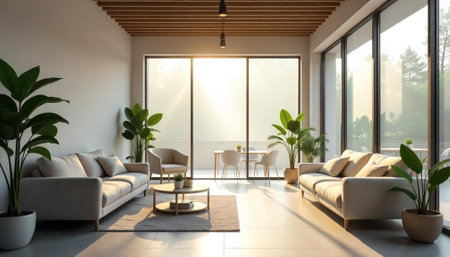Importance of Natural Light in Indian Homes
Natural light is an essential feature in every Indian home, blending practicality with tradition. Sunlight not only brightens up living spaces and uplifts the mood of family members, but also plays a significant role in reducing monthly electricity bills. With the abundance of sunlight across most parts of India, harnessing this free natural resource makes economic sense, especially with rising energy costs. Moreover, natural light is deeply connected to Vastu Shastra, the ancient Indian architectural science. According to Vastu principles, proper orientation and entry of sunlight into the house bring positive energy, health, and prosperity to its residents. Well-lit homes are believed to promote happiness and harmony, while dark or poorly lit spaces are avoided as they may attract negative vibes. Therefore, incorporating generous windows, skylights, or open courtyards in home design is not just a modern trend but also a continuation of age-old Indian values. Whether you live in a bustling city flat or a spacious bungalow in Kerala, prioritizing natural light is key for comfort and well-being.
Ventilation Solutions for Indian Climates
Indian homes face unique climate challenges, from intense heat to high humidity. To address these, traditional and modern ventilation solutions are essential for comfortable and healthy living spaces. Here, we explore time-tested Indian methods that ensure cross-ventilation, control humidity, and keep interiors cool—perfectly complementing the essentials of natural light and plant growth.
Popular Indian Ventilation Methods
Traditional architecture in India has long prioritized passive cooling techniques. Among the most effective are Jali windows (intricately carved stone or wooden screens) and high ceilings. These features not only improve air circulation but also help filter harsh sunlight while allowing fresh breezes indoors.
| Ventilation Method | Description | Benefits |
|---|---|---|
| Jali Windows | Perforated screens made from stone or wood, placed on windows or walls. | Enhances airflow, reduces glare, maintains privacy, and supports plant health by diffusing light. |
| High Ceilings | Ceiling heights typically above 10 feet in living spaces. | Promotes hot air rise and expulsion, keeps rooms cooler, allows for taller indoor plants. |
| Verandas & Courtyards | Semi-open spaces adjoining main rooms or central open areas within the home. | Facilitates cross-ventilation and creates microclimates ideal for plant growth. |
| Louvred Windows & Vents | Tilted slats or openings at different heights. | Allows adjustable airflow without compromising security or rain protection. |
Humidity Control Tips
In many parts of India, especially during monsoon season, controlling humidity is crucial. Using natural materials like terracotta tiles and lime plaster on walls helps absorb excess moisture. Proper ventilation—through openable windows and exhaust fans in kitchens and bathrooms—prevents mould and keeps indoor plants healthy.
Modern Adaptations for Indian Homes
Today’s urban Indian homes can combine these traditional elements with energy-efficient ceiling fans, solar-powered ventilators, and strategically placed mesh screens to keep mosquitoes out while letting air flow freely. By integrating these solutions with natural light sources, your home will remain airy, bright, and ideal for both your family and your indoor garden.
![]()
3. Incorporating Indoor Plants: Vastu and Wellness
Indoor plants play a vital role in Indian homes, not just for their aesthetic appeal but also for their deep-rooted connection to health, spirituality, and Vastu Shastra. Selecting the right indoor plants can transform the energy of your living space, enhance natural light usage, and improve air quality.
The Significance of Tulsi (Holy Basil)
Tulsi is considered sacred in most Indian households. According to Vastu, placing Tulsi near windows or balconies in the north, east, or northeast direction attracts positive energy and purifies the environment. Beyond spiritual benefits, Tulsi improves indoor air quality and is known for its medicinal properties—boosting immunity and reducing stress levels.
Money Plant: Prosperity & Air Purification
The Money Plant is a favourite choice for Indian homes due to its association with wealth and prosperity. Vastu suggests keeping the Money Plant indoors, especially in the southeast corner, to promote financial stability and harmonious relationships. Additionally, this plant is efficient at filtering indoor pollutants, making it ideal for improving air circulation and benefiting overall well-being.
Integrating Plants with Natural Light & Ventilation
For optimal growth and Vastu harmony, ensure that these plants receive ample natural light without direct harsh sunlight. Good ventilation supports plant health and helps distribute their positive energy throughout your home. Combining thoughtful placement of indoor plants with effective use of natural light creates a balanced, vibrant atmosphere essential for Indian living spaces.
Cultural Practices for Daily Wellness
Regularly watering and caring for indoor plants like Tulsi and Money Plant is deeply embedded in daily routines across India. These acts are seen as both spiritual offerings and practical steps towards sustaining a healthier home environment. By integrating such practices into your lifestyle, you align your home with both nature’s wisdom and traditional Indian values.
4. Traditional Design Practices: Courtyards and Verandahs
Indian homes have always celebrated the natural environment through smart architectural features that welcome sunlight, fresh air, and lush greenery indoors. Among these, open courtyards (angan), verandahs, and intricately carved jaali screens are timeless elements that remain relevant in modern Indian living.
Courtyards (Angan): Bringing Nature Home
The heart of many traditional Indian homes is the courtyard. These open-to-sky spaces act as natural light wells, allowing ample sunlight to reach interior rooms while creating a cool microclimate. The angan also supports plant growth—from holy tulsi to seasonal flowers—fostering a sense of wellbeing and connection to nature. Families gather here for morning tea or festive rituals, making the courtyard a centre of both comfort and community.
Verandahs: The Transitional Spaces
Verandahs are semi-open corridors that wrap around the house, providing shade from harsh sunlight while promoting cross-ventilation. Especially during sultry summers, these spaces offer respite and invite gentle breezes indoors. Verandahs are ideal spots for potted plants, swings (jhoola), and social gatherings, perfectly blending functional comfort with cultural tradition.
Jaali Screens: Artistry Meets Utility
Jaali—latticed stone or wooden screens—are an iconic feature in Indian architecture. They filter strong sunlight into soothing patterns and maintain privacy without blocking airflow. Their intricate designs not only add aesthetic value but also enable healthy ventilation and optimal daylight, supporting indoor plant life even in compact urban settings.
Key Benefits of Traditional Elements
| Design Element | Natural Light | Ventilation | Plant Growth |
|---|---|---|---|
| Courtyard (Angan) | Excellent | Optimal Air Circulation | Ideal for Gardens & Pots |
| Verandah | Filtered Light | Breezy Transition Zones | Potted Plants & Vines |
| Jaali Screen | Dappled Sunlight | Sustained Airflow | Supports Indoor Greenery |
These traditional practices not only reflect India’s rich cultural heritage but also address practical needs for healthier, more sustainable homes. By embracing courtyards, verandahs, and jaali in contemporary design, homeowners can ensure their living spaces stay bright, airy, and green—just as our ancestors envisioned.
5. Modern Innovations with Indian Touch
Skylights: Bringing Surya’s Blessings Indoors
Integrating skylights in Indian homes is becoming increasingly popular, especially in urban areas where space is limited. Skylights not only allow natural light to flood into the interiors, reducing the need for artificial lighting during the day, but they also honour the traditional Indian value of welcoming sunlight (Surya) as a source of positive energy. Modern skylight designs can be fitted with heat-resistant glass or adjustable blinds, making them suitable for the intense Indian summers while preserving indoor comfort.
Ventilated Bricks: Tradition Meets Technology
Ventilated bricks, often known as jaali or perforated bricks, are rooted in classic Indian architecture but have seen a revival with modern materials and construction techniques. These bricks facilitate cross-ventilation and help maintain cooler indoor temperatures—a much-needed feature in India’s varied climates. Additionally, jaali patterns add an aesthetic charm reminiscent of Mughal and Rajasthani heritage, blending functionality with cultural beauty.
Green Walls: Urban Gardening Reimagined
As urban spaces shrink, vertical gardens or green walls offer an innovative way to incorporate plant life into Indian homes. These living walls are designed using native plants that thrive in local conditions, making maintenance simple for city dwellers. Besides purifying air and enhancing visual appeal, green walls connect residents with nature—an important aspect of Indian culture that values harmony between people and their environment.
Respecting Culture While Embracing Progress
While these modern features bring technological advancement to Indian homes, their thoughtful adaptation ensures that cultural aesthetics and traditional wisdom are never compromised. By combining skylights, ventilated bricks, and green walls with indigenous design elements like intricate latticework or locally sourced materials, homeowners can create spaces that are both contemporary and deeply rooted in Indian ethos.
Towards Sustainable Urban Living
Incorporating these innovations not only improves natural light, ventilation, and plant growth within urban Indian homes but also supports eco-friendly living—a value intrinsic to many Indian philosophies. As cities grow denser, such solutions will become essential in shaping sustainable and culturally resonant living environments for future generations.
6. Practical Tips for Indian Households
Maximizing Natural Light on a Budget
Use Sheer Curtains
Replace heavy drapes with sheer or light-coloured cotton curtains to let in more sunlight while maintaining privacy. Popular in many Indian homes, these can be easily washed and are affordable.
Strategic Mirror Placement
Hang mirrors opposite windows or balcony doors to reflect daylight deeper into your rooms. This simple trick brightens up even smaller flats common in urban India.
Improving Ventilation Easily
Open Windows at the Right Time
Open windows early morning and late evening when outdoor air quality is better and temperatures are cooler. This is especially helpful during hot Indian summers or the monsoon season.
Install Exhaust Fans
Use energy-efficient exhaust fans in kitchens and bathrooms to remove moisture and odours quickly, reducing mould growth—a common issue in humid Indian climates.
Nurturing Indoor Plants: Indian Family Edition
Choose Hardy, Local Plants
Select low-maintenance plants like money plant (Epipremnum aureum), tulsi (holy basil), or snake plant. These are commonly available at local nurseries and thrive well indoors across most Indian cities.
Reuse Household Items as Planters
Give a second life to old plastic bottles, matkas (earthen pots), or steel containers by turning them into planters. This eco-friendly practice is pocket-friendly and encourages sustainable living.
Quick Watering Tip:
Water plants early morning or after sunset to avoid rapid evaporation, especially in hotter regions like Rajasthan or Tamil Nadu.
Small Steps, Big Difference
By making a few small changes—like rearranging furniture to allow sunlight, cross-ventilating rooms, and introducing easy-care indoor plants—Indian families can create healthier, brighter living spaces without major expenses. Start today and enjoy the natural benefits every day!


